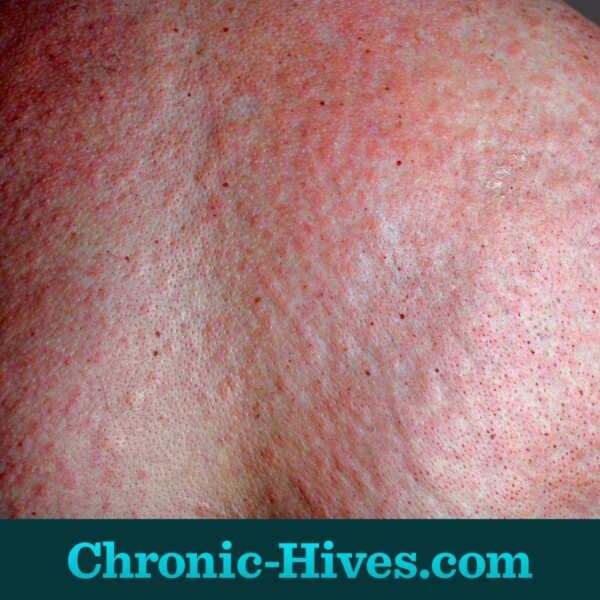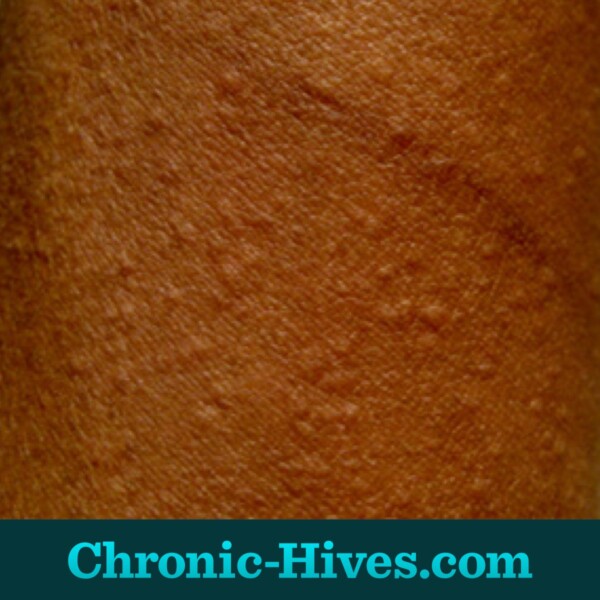What Are Chronic Hives?
Reviewed by: HU Medical Review Board | Last reviewed: April 2022 | Last updated: October 2025
Hives are red, itchy bumps on your skin. Chronic hives are a condition where hives come and go for 6 weeks or more. Usually, there is no known cause of chronic hives.1
Doctors diagnose chronic hives using your health history and physical exams. The standard treatment is antihistamines, though treatment can include other drugs. Symptoms usually resolve within a couple years. But chronic hives can impair quality of life and mental health.
Terms used to describe chronic hives
Doctors use many terms when describing chronic hives, including:2
- Chronic – Lasting 6 weeks or longer
- Urticaria – Red, itchy bumps on the skin (also called hives, welts, or wheels)
- Spontaneous – Happening without a specific trigger
- Idiopathic – Without a known cause
- Angioedema – Swelling in deep layers of tissue, often related to hives
Experts often use the terms chronic idiopathic urticaria (CIU) and chronic spontaneous urticaria (CSU). These both mean the same thing as chronic hives. But they specify that the hives have no known triggers or causes, unlike physical or inducible urticaria.2
How many people have chronic hives?
About 1.6 million people in the United States have chronic hives. Chronic hives can affect anyone, but the condition typically starts between 20 to 40 years old. Women develop chronic hives twice as often as men.1

What causes chronic hives?
In 90 percent of chronic hives cases, the triggers and causes are unknown. However, there may be environmental factors that worsen symptoms. These include:2,3
- Heat
- Tight clothing
- Anti-inflammatory drugs
- Stress
- Dietary changes
We know that hives happen when certain cells release a chemical called histamine, which causes many of the symptoms of allergies. But we do not know what causes cells to release histamine. There may be an autoimmune reaction involved. People with chronic hives may also have defects in cells that release histamine. But we do not have enough evidence to prove these theories.2,4
What are symptoms of chronic hives?

Photo courtesy of Wikimedia Commons under Attribution 3.0 Unported license, viewable here: https://creativecommons.org/licenses/by/3.0/deed.en
The main symptom of chronic hives is red or skin-colored welts that appear anywhere on the body. This is called urticaria. Some features of urticaria include:2,3
- An area of swelling of various size surrounded by redness
- Itching sensation
- Tendency for each welt to last less than 24 hours
Body parts where clothing compresses skin may be affected more intensely. When hives cause itching, scratching injuries and infections can happen.2
Many people with chronic hives also experience swelling around eyes, lips, and face. This is called angioedema. Some people get hives and angioedema together. Other people have angioedema without hives. This swelling often feels painful or numb.5,6
Some people with chronic hives experience other symptoms. These are more common among people with more severe and longer-lasting disease. Some of these symptoms include:2
- Headache
- Fatigue
- Pain or swelling of joints
- Wheezing
- Flushing
- Gastrointestinal (GI) symptoms
How are chronic hives diagnosed?
The key diagnostic feature is the presence of hives for 6 weeks or longer without any known cause. To diagnose this, doctors first rule out other conditions that cause hives, such as autoimmune conditions and allergies.2,7
Your doctor will use your health history and physical exams to distinguish chronic hives from other conditions. They will ask questions and perform tests to make sure there is no evidence of a more serious condition.2,3
How are chronic hives treated?
The goal of treatment is to reduce symptoms and eliminate flares. Treatment will usually include a combination of:7,8
- Medicines
- Lifestyle changes
- Avoiding any known triggers
- Education
Treatment guidelines suggest a step-based approach to using medicines. Doctors start with over-the-counter, non-drowsy antihistamines. If these do not control symptoms, your doctor may try:7,8
- Increasing your dose of non-drowsy antihistamines
- Adding another non-drowsy antihistamine
- Adding an H2 antihistamine
- Adding a leukotriene receptor antagonist
- Adding a drowsy antihistamine at bedtime
If these still do not control symptoms, your doctor may try adding other types of drugs, including:7,8
- Oral steroids, such as prednisone
- Antidepressants, such as doxepin (Zonalon®)
- Monoclonal antibodies, such as omalizumab (Xolair®)
- Immune-suppressing drugs, such as cyclosporine
About half of people with chronic hives respond well to antihistamines. About 65 percent of the remaining people respond well to omalizumab.9
What is the prognosis for chronic hives?
Chronic hives are not a life-threatening condition. Most cases of chronic hives go away within a couple years. Fewer than 30 percent of people experience symptoms for longer than 5 years. Longer disease is linked to worse symptoms.2
Random episodes of itchy and painful skin disrupt daily life. Chronic hives have a large impact on quality of life and mental health. About 1 in 7 people with chronic hives report emotional distress. This is because people with chronic hives often experience:1
- Pain and fatigue
- Difficulty sleeping
- Anxiety about when symptoms will flare
- Depression
- Shame and social stigma
- Loss of work productivity